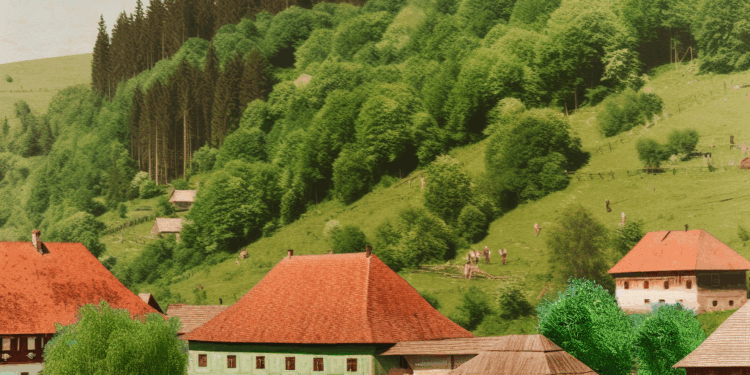Bukovina, a land with a diverse ethnic composition and a colourful cultural history, is often overshadowed by the better-known regions of Ukraine and Romania. Many cultures, religions and languages crossed paths on its territory, making it unique in the context of Eastern European history. In this article, we will look at little-known but significant facts about its history, from princely times to the Soviet era.
Princely times: identity formation
Principality of Galicia-Volynia (till XIII century)
Some consider Bukovina to be part of the Principality of Galicia-Volhynia, which was one of the largest political entities in Eastern Europe in the 12th-13th centuries. During this time, the foundations of local culture, language and writing were laid. Archaeological finds show that there were trade routes connecting the Black Sea region and Central Europe in Bukovina. This contributed to the development of local towns, which had trade links with other principalities.
Khotyn Castle (XIII century)
One of the significant symbols of the past centuries is the Khotin Castle, which was built in the XIII century. The castle served as an important defence structure and controlled trade routes along the Dniester River. Khotin was not just a military fortress, but also a cultural centre. Important princely gatherings were held here, which emphasises its political importance. One such event was the Battle of Khotyn in 1621, when Polish troops defeated the Turks.
Austrian Empire: cultural transformation and modernisation
Accession to the Austrian Empire (1775)
In 1775.
Bukovina was annexed by the Austrian Empire, which marked the beginning of a new era in the history of the region. Under the Austrian administration, the local population received more rights and privileges. The Austro-Hungarian Empire actively implemented programmes of infrastructure modernisation – roads, railways and provincial institutions were built, which contributed to the economic growth of the region.
The role of ethnic minorities
In the Austrian Empire, Bukovina attracted many ethnic minorities: Ukrainians, Romanians, Jews, Germans, and Poles. This diversity created a unique cultural palette. Various schools began to develop on this land, including Jewish and Ruthenian schools. One of the little-known facts is that Chernivtsi was home to one of the first Jewish libraries in the early 20th century, which confirms the high cultural activity on this topic.
Chernivtsi: cultural centre
From the beginning of the XIX century Chernivtsi became an important cultural and educational centre of the region. In 1875, the Chernivtsi University was founded, which quickly gained fame as one of the best educational institutions in Europe. It is an important fact that outstanding figures of science and culture, such as writer and philosopher Anatole France, who became a Nobel Prize winner, studied here.
The interwar years: the struggle for identity
Annexation to Romania (1918)
After the First World War, Bukovina was ceded to Romania in 1918, which caused dramatic changes in politics, cultural life and the ethnic structure of the population. The locals experienced difficulties with the new language laws and the requirement of Romanian citizenship.
Development of cultural life
Despite the political difficulties, the interwar years were a time of active cultural development. During this period, cultural events such as exhibitions, theatre performances and literary evenings were held in Chernivtsi and other cities. Particular attention should be paid to the emergence of a unique Romanian theatre, which became a meeting place for many artists and literary figures.
The Soviet Era: Challenges and Transformations
Accession to the Soviet Union (1940)
In 1940, during the Second World War, part of Bukovina was annexed to the Soviet Union. This transition was dramatic not only politically but also socially. Many residents faced repression and resettlement. In the absence of significant changes in government, many local organisations were closed or nationalised.
Modernisation and industrialisation
Although the early years of Soviet rule were difficult, industrialisation began in the region from the late 1940s onwards. The opening of new factories and enterprises was an important stage in the development of Bukovina. In particular, the timber industry was actively developing in Chernivtsi, which helped provide jobs for the local population.
Cultural life under Soviet rule
The Soviet era, despite the authorities’ desire to unify cultural life, favoured the emergence of unique artistic trends. In addition, there was an active development of Ukrainian literature during this time, which gave birth to many famous authors and poets, such as Vasil Stus.
Conclusion
The history of Bukovyna is not a simple line of events, but a complex landscape of complementary cultures and ethnicities. It has passed through different epochs, each of which left its mark on the formation of its unique identity. The facts presented here emphasise how the diversity and dynamism of this land has contributed to its diverse cultural and social life, important not only for Ukraine but for the whole of Eastern Europe.
The history of Bukovyna is also important for understanding current processes in the region, as allusions to its rich cultural heritage continue today. The region shows how identity can be multilayered and complex, which makes it even more attractive for study and reflection.








